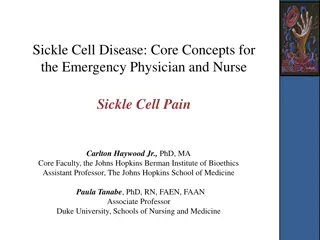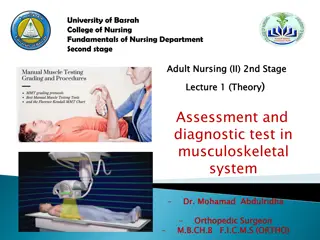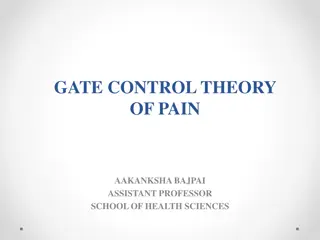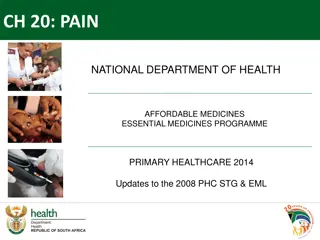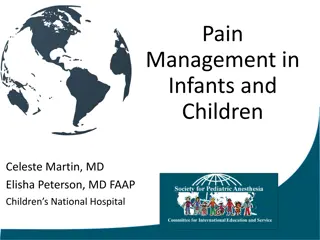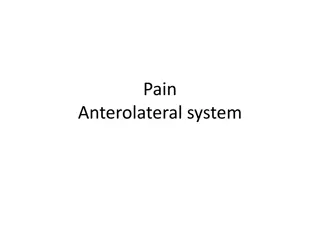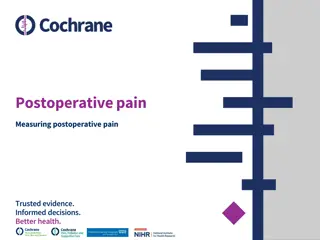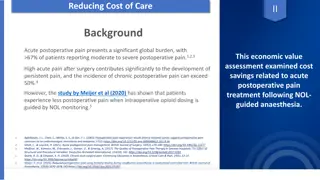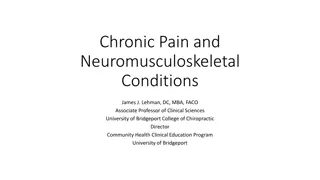
Effective Pain Management Strategies
Pain can be categorized into three basic types: acute, chronic, and cancer-related. Understanding the nature of pain is crucial in providing appropriate care and treatment. Proper pain assessment involves observing patients, noting their behaviors, and eliciting detailed descriptions of their pain experiences. By defining and assessing pain effectively, healthcare providers can better address patients' needs and improve their quality of life.
Download Presentation

Please find below an Image/Link to download the presentation.
The content on the website is provided AS IS for your information and personal use only. It may not be sold, licensed, or shared on other websites without obtaining consent from the author. If you encounter any issues during the download, it is possible that the publisher has removed the file from their server.
You are allowed to download the files provided on this website for personal or commercial use, subject to the condition that they are used lawfully. All files are the property of their respective owners.
The content on the website is provided AS IS for your information and personal use only. It may not be sold, licensed, or shared on other websites without obtaining consent from the author.
E N D
Presentation Transcript
Outline Assessment of Pain Patient controlled anesthesia
Definition of Pain an unpleasant sensory and emotional experience associated with actual or potential tissue damage (Merskey & Bogduk, 1994). It is the most common reason for seeking health care. It occurs with many disorders, diagnostic tests, and treatments. It disables and distresses more people than any single disease.
Three Basic Categories of pain A. ACUTE PAIN - recent onset and commonly associated with a specific injury, indicates that damage or injury has occurred. lasts from seconds to 6 months. In a situation where healing is expected in 3 weeks and the patient continues to suffer pain, it should be considered chronic and treated with interventions used for chronic pain.
Three Basic Categories of pain B. CHRONIC (NONMALIGNANT) PAIN Chronic pain is constant or intermittent pain that persists beyond the expected healing time and that can seldom be attributed to a specific cause or injury. It may have a poorly defined onset, and it is often difficult to treat because the cause or origin may be unclear. pain that lasts for 6 months or longer, Nevertheless, after 6 months, most pain experiences are accompanied by problems related to the pain itself.
Three Basic Categories of pain C. CANCER-RELATED PAIN may be acute or chronic. it is the second most common fear of newly diagnosed cancer patients ( 1ST is fear of dying) can be directly associated with the cancer (eg, bony infiltration with tumor cells or nerve compression) ; a result of cancer treatment (eg, surgery or radiation); or not associated with the cancer (eg, trauma). a direct result of tumor involvement.
PAIN ASSESSMENT 1. Observe the patient carefully, noting the patient s : A. overall posture B. presence or absence of overt pain behaviors C. ask the person to describe, in his or her own words, the specifics of the pain. * The words used to describe the pain may point toward the etiology. * A detailed history should follow the initial description of pain.
Pain Assessment P Precipitating/Alleviating Factors Q Quality of Pain: R Region and Radiation S Severity T T iming
EFFECTS OF ACUTE PAIN Unrelieved acute pain can affect the: A. pulmonary, B. Cardiovascular C. Gastrointestinal D. Endocrine E. immune system The patient with severe pain and associated stress may be unable to take a deep breath and may experience increased fatigue and decreased mobility. Although these effects may be tolerated by a young, healthy person, they may hamper recovery in an elderly, debilitated, or critically ill person. Effective pain relief may result in a faster recovery and improved outcomes.
EFFECTS OF CHRONIC PAIN 1. Suppression of the immune function associated with chronic pain may promote tumor growth. 2. depression 3. disability
Non-Pharmacological Interventions Heat & Cold applications Relaxation techniques, distraction Music therapy Massage NOTE: The above management techniques are meant to supplement, not replace pharmacological interventions.
PCA Patient Controlled Analgesia
What is Patient Controlled Analgesia? Patient Controlled Analgesia (PCA) uses a programmable syringe pump to allow patients to self-administer their own intravenous analgesia.
Understanding PCA The PCA device is a programmable syringe pump, which delivers the opioid infusions according to individualised settings: Bolus dose Lockout time Dose duration Background infusion
Bolus dose When the patient presses the remote button, the PCA delivers the programmed bolus dose. In cases of severe pain or in patients with large opioid requirements the bolus dose may be several times higher than the usual protocol
Lockout time Lockout time is usually set at 5 minutes The PCA will not deliver a dose during lockout time, even if the patient presses the button This allows each bolus to reach peak effect before the patient has another bolus Lockout time reduces the risk of overdose
Good tries / Bad tries A good try is when the PCA delivers a bolus dose of analgesia. A bad try is when the patient presses the button during the lockout time and no bolus dose is delivered. Knowing the proportion of good and bad tries allows medical staff to adjust the PCA settings to meet the patient s needs or whether further patient education is required.
Dose duration Dose duration is normally set as stat Alaris PCA stat is 70 seconds The dose duration may be increased to prevent problems such as light-headedness or nausea associated with a rapid peak of onset of analgesia.
Background infusion Background infusion (continuous infusion) may be added to improve analgesia Generally background infusion is only required for patients following major surgery or patients with oncology-related pain and high opioid requirements Background infusions may increase the risk of the side effects associated with opioids: sedation, respiratory depression, itch, nausea.
Advantages of PCA Pain is in control by patient Rapid response to demand for analgesia Reduced patient anxiety Fewer complications Increased staff, patient and family satisfaction Decreased staff workload
Patient selection ( Indication ) : PCA is suitable for treatment of most types of acute and acute-on-chronic pain: Surgical Medical Trauma Burns Oncology
Contraindications to PCA Inability to understand the concept of PCA Children not wishing to control their own analgesia.
Nursing role for patient using PCA Adjust Correct dose of opioid Accurate documentation Observation of vital signs Documented pain scores Monitoring: sedation scores respiratory effort, rate, depth oxygen saturation heart rate The number of good and bad tries are documented The total dose of opioid received is also recorded
Pre-operative education The anaesthetist will discuss PCA with the patient pre- operatively Explain the basic principles of PCA to patient prior to surgery Reminding patient post-operatively about using PCA effectively Reference: Smeltzer and Bare . Brunner & Suddarth s Medical Surgical Nursing
video https://www.youtube.com/watch?v=lHR0yz7z 4Oo


